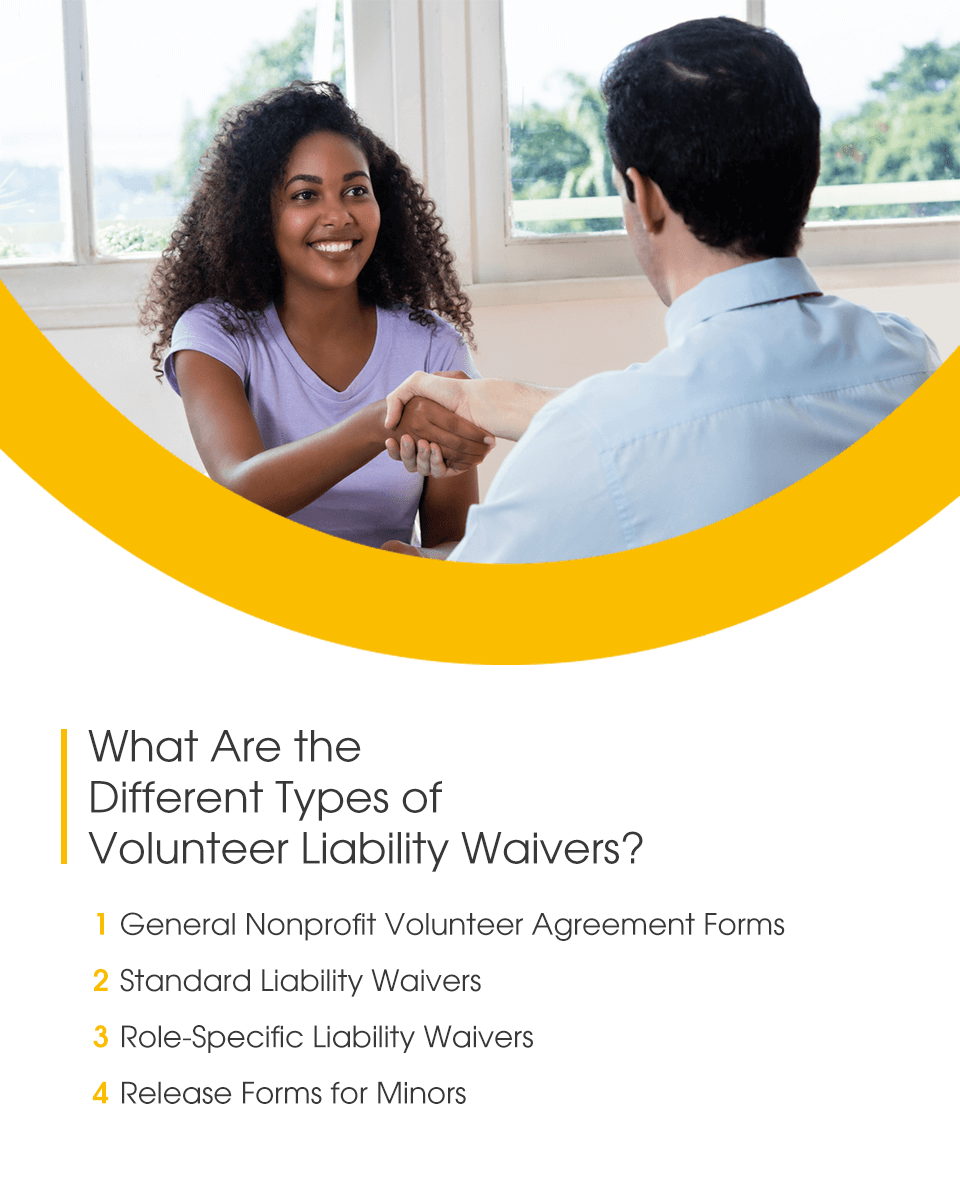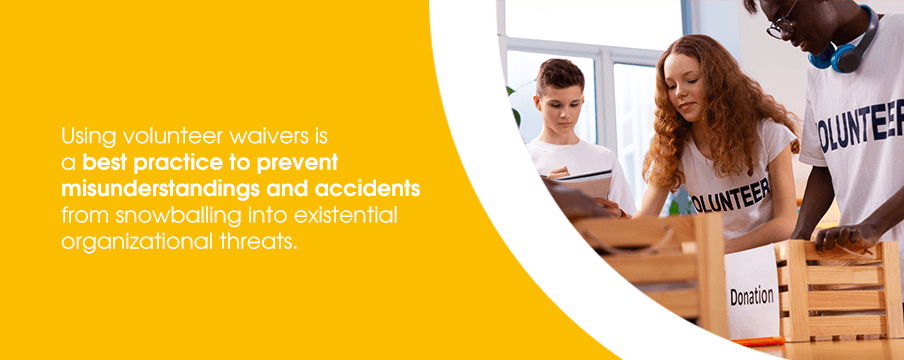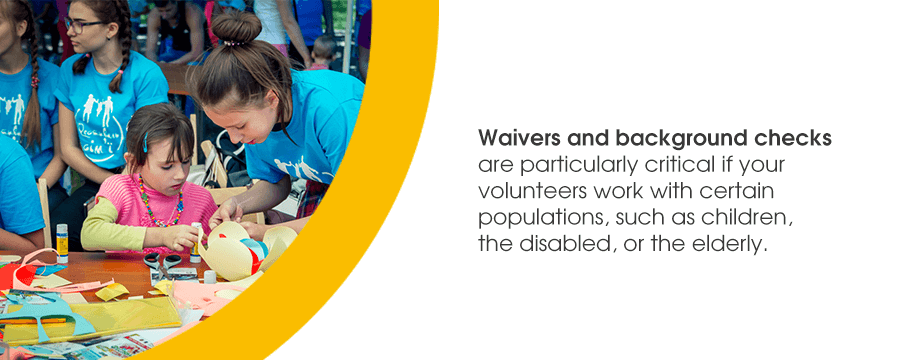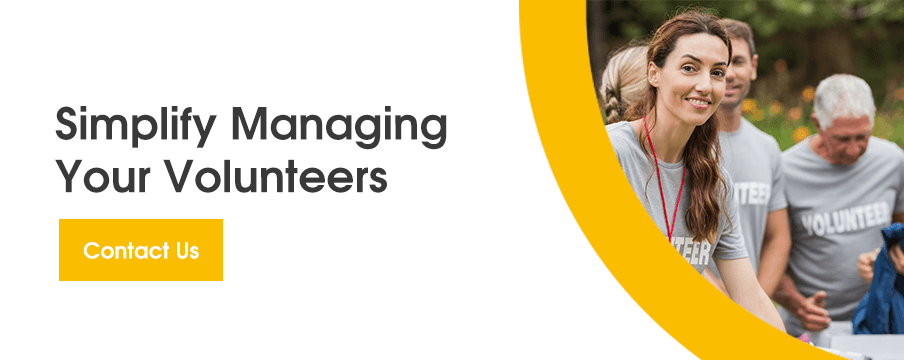

![]()
![]()
![]()
![]()
Organizations often avoid using volunteer waiver agreements for several reasons. Administrators may feel the nature of volunteer roles doesn’t call for such strong legal documents, or work only with a select group of seasoned volunteers whom they know and trust. Likewise, they may simply not have the time to create these formal waivers or understand their benefits.
With these tips for implementing volunteer waiver forms, you’ll be able to create and manage these crucial documents with ease. Doing so will save time, energy, and legal culpability, so your organization can operate with peace of mind.
A volunteer liability waiver form is an official document volunteers sign indicating their consensual participation in activities or roles hosted by your organization.
Also known as a release form, waivers illustrate potential physical or environmental risks inherent to the volunteer opportunity. For example, it’s common to have volunteers sign waivers before physically demanding or strenuous manual work, such as renovating a local home, giving consent to operating a vehicle, or before working with specific vulnerable populations.
Volunteers read and then sign waivers. Their signatures constitute a legally binding agreement noting the individual’s understanding of the stated risks involved with their commitment, as well as waiving their rights to place liability back on your nonprofit or organization in the event of an accident while volunteering.
Due to their indication of awareness and consent, volunteer waivers are considered a document of understanding. Organizations should use volunteer waivers, releases, or similarly named agreement forms as a general best practice, to protect the organization from complicated legal situations before the volunteer’s actual shift. As a bonus, release waivers also provide transparency to your volunteers, clarifying role expectations while maintaining clear lines of communication with anyone dedicating time to your causes.

There are several types of liability waivers utilized by nonprofits and other organizations. Each type of volunteer waiver may be important for your organization to have on-file and ready for signing, depending on the nature of a volunteer’s role and the individual’s level of commitment. Some common types of volunteer liability waivers include:
General volunteer waivers for nonprofits are the most basic and approachable document of understanding.
With general waivers, participants agree to acquit your organization of any legal accountability should accidents or damages occur during a volunteer activity. These documents also tend to state the relationship between the host and the participants.
Some volunteers may be intimidated or off-put by the intensity of terms like “waiver” and “liability release.” For this reason, general volunteer agreements serve as a bridge to protect your organization’s actions while simultaneously educating volunteers on their rights and roles, plus any other participatory rules you’d like established at the onset of the relationship.
Otherwise known as a generic or simple volunteer waiver forms, standard liability documents present a broad basis of legal coverage fundamentally designed to protect your organization.
In general, standard liability waivers work best when:
Standard liability waivers are just that — standard. As a document, it offers you robust coverage that will be recognized and enforced in a court, if necessary. Search for examples of the language and terms innate to this type of volunteer liability waiver to better understand what to cover in your own related documents.
With a role-specific volunteer waiver of liability, your organization drafts and documents specific release forms for each type of volunteer position.
Role-specific waivers help outline more granular volunteerism risks and parameters, particularly citing the requirements needed to fulfill each role safely. For example, a volunteer position at a food shelter may require an individual to drive around picking up donations from local restaurants, food vendors, and partners, meaning a role-specific liability waiver should include proof of a driver’s license and a defensive driving course certificate.
A role-specific waiver also outlines any potential risks working with:
Organizations working with volunteers under the age of 18 must first receive parent or guardian consent before formally adding the minor onto its volunteer schedule. These volunteer release forms are required by labor laws and ensure your organization is following industry regulations.
Generally, volunteer waivers for minors consist of lines for the parent or guardian to sign, lines for the volunteer manager or director to acknowledge and then short liability release clauses. They can also include the signatures of the youth volunteering themselves.
Organizations should generally always have volunteers sign waivers at the onset of volunteer screenings — or during whatever formal onboarding or orientation process your organization supports.
Regardless of the type of work a volunteer will perform, their level of commitment, their frequency of volunteering, or their familiarity with your organization, using volunteer waivers is a best practice to prevent misunderstandings and accidents from snowballing into existential organizational threats.
In some cases, they’re also mandatory — such as when screening youth volunteers.
Generally, volunteer waivers are necessary when and if:

Luckily, your nonprofit doesn’t need an in-house legal expert to know how to create volunteer releases and waivers.
Use these suggestions as a general outline for writing your agreement forms, ensuring a functionally — and legally — robust document serving everyone’s well-being.
A statement of activities clause provides volunteers with a general sense of the responsibilities involved in their new roles. These activities range but may include:
A statement of activities section is particularly essential when drafting a role-specific waiver. It is also a good practice for minor waiver forms, as it provides a definitive description for parents or guardians to understand what their child will be doing with your organization.
Using waivers is a great way to describe any physical requirements related to volunteering at your organization.
This description also gives autonomy and agency back to the volunteer. Individuals can assess if their health and physical well-being are suited to your organization’s needs on their own terms, taking their volunteer activities into their own hands.
Some common physical requirements included on waivers are:
After outlining basic physical requirements and duties, volunteer waivers must state that your organization is not responsible for physical, mental, or emotional repercussions involved in a volunteering incident.
Often, these clauses are worded under an “assumption of risk” paragraph. If signed, volunteers state they understand the inherent risks of their roles or tasks and assume the full responsibility of any injuries and harm from them, therefore releasing your organization from liability.
In addition to daily roles and responsibilities, plus an assumption-of-risk statement, volunteer waivers can describe the general safety rules and parameters involved in assisting at your organization.
These rules may be helpful to minors or child volunteers to understand appropriate behaviors during their volunteer shifts. More broadly, they can be age-related, skills-related, or any other qualifying variable relevant to the roles at hand.
Furthermore, safety procedures document any compliance measures you and your volunteers must follow. Finally, you can use the safety rules and procedures clause to state your organization has no liability to carry insurance benefiting the volunteer, and that such insurance falls on them.
A media or publicity release gives your organization permission to use a volunteer’s images or quotes across publications.
From social media campaigns to press releases to formal grant-writing applications, a publicity release identifies which media a volunteer is or isn’t comfortable with having in the public eye, namely:
Volunteers then grant you permission to all “rights” and “titles” of that media, meaning they consent to those images, clips, or likenesses being used how you choose.
A permission to treat section releases your nonprofit from legal repercussions if first aid or any similar medical service is rendered during a volunteer’s time at your organization. Volunteers cannot file claims indicating your organization is to blame for the initial health or medical emergency, or for health issues that arose after or in connection to an incident.
A permission to treat section additionally grants you the right to perform emergency medical treatments on a minor at the expense of the guardian or parent — not your organization.
Participant consent lays out the descriptions, responsibilities, rules, and acceptance of risks narrated across the entire waiver.
The language of your liability release is important. Many nonprofits and organizations choose to employ verbatim that the volunteer is “willingly,” “actively,” and “voluntarily” signing the release with their full expressed consent and intent. By signing the release, the volunteer agrees to all the aforementioned clauses — and checks off an essential part of your successful volunteer screening and orientation process.
These volunteer waiver tips ensure your entire form-management system is smooth, straightforward, and — most importantly — simple for you and your volunteers alike to understand.
Volunteer management software simplifies and streamlines the entire waiver process. From storing signed documents to moving away from fragile paper systems, these programs are designed for compatibility with multiple file forms, including .docx, .pdf, .png, .xlsx, .txt and more.
Managing volunteer waivers through software allows you to:

Waivers and background checks are particularly critical if your volunteers work with certain populations, such as children, the disabled, or the elderly.
Build waiver signing and release statements into the earliest days of your organization’s overall volunteer recruitment pipeline. The process will grow simpler and more organic the longer it’s supported, and you’ll get better at writing for your organization’s specific consent and liability needs.
Transparency is at the heart of every type of volunteer waiver:
Volunteer waivers are necessary to close any gaps in understanding of duties and responsibilities. The clearer and more direct your language, the better. Then, if any accidents or issues arise, you have clear proof of accountability tucked in your back pocket, ready to objectively mediate misunderstandings.
Even non-role-specific waivers can learn a lot from role-geared ones — that’s because this kind of liability release provides clear details on the nature of a volunteer’s work and level of commitment, giving all parties time to understand and sign-off on the relationship.
Use your volunteer release forms as the central piece of paper illustrating any of these requirements as early as possible:
Certain volunteer situations and demographics will be better suited toward traditional print waivers, such as senior volunteer positions with many hours a week and more formal role documentation subsequently required. For others, an online liability waiver makes more sense, such as during major public-facing events like charity runs, where large groups of people will need to sign off before participating.
In either case, volunteer management software with document storage functions makes cataloging your waivers easy, regardless of the original format, amount, or timeline.
Consider having your volunteer releases and waivers of liability read over by someone with legal expertise. Law students at local universities, as well as firms with pro-bono programs, make great resources, especially to ensure your forms are understandable and accessible, yet contain legally pertinent language.
There is a legal difference between the terms “liability waiver” and “liability release.”
Luckily, most organizations don’t need to be ensnared in a terminology rabbit hole. Organizations can simply skirt confusion by wording both a liability waiver and a liability release into all their volunteer forms across all different volunteer capacities.

Using the right volunteer management software is the ticket to improving your volunteer operations, with these programs serving as your right-hand tool across tasks and to-dos.
Demo our industry-leading platform today to see for yourself how much more you can accomplish with Volgistics.
Categories: Tips Tags: waivers Leave a commentYou must be logged in to post a comment.